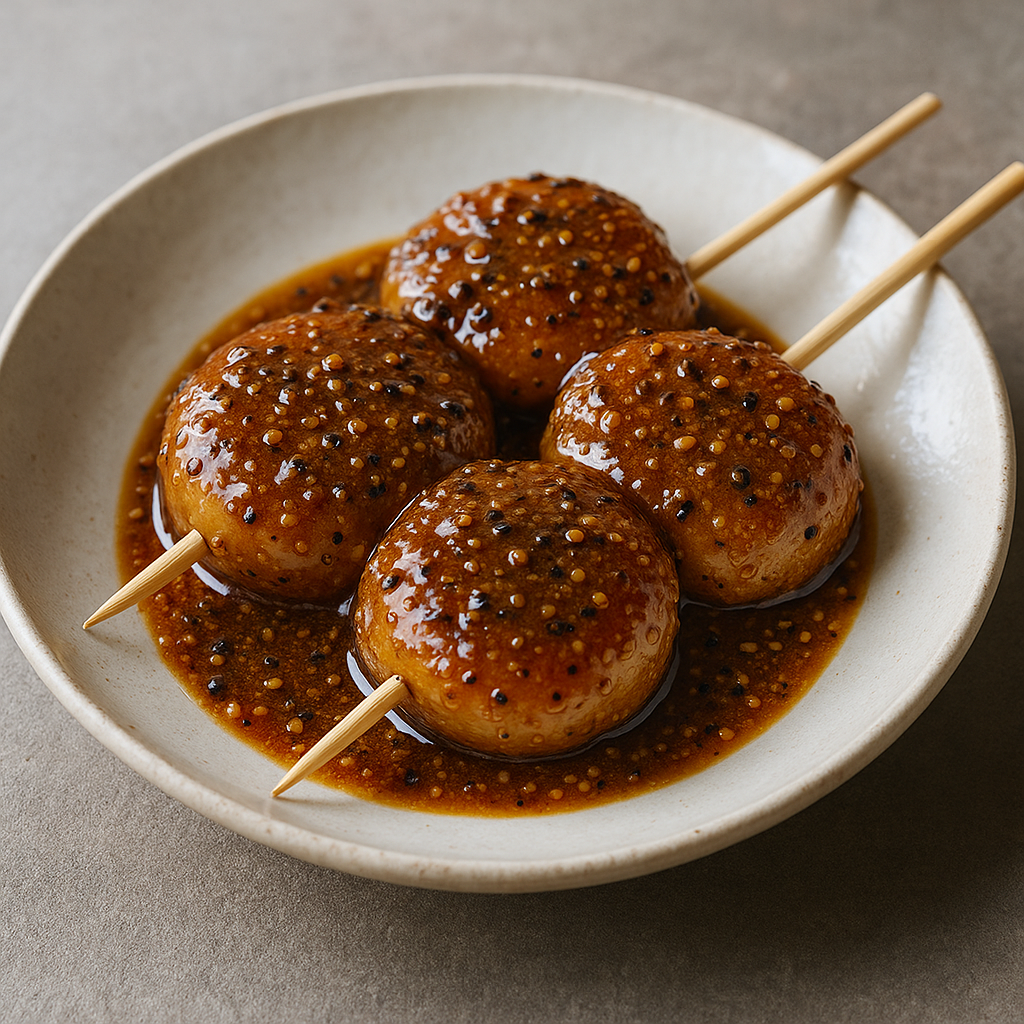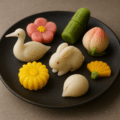かまもちの特徴
釜で蒸してつく、香ばしさが映える素朴なもち
かまもちは、もち米を釜(鍋や蒸し器)でしっかり蒸してからつき、薄くのして焼き目をつけたり、たれを絡めたりしていただく郷土のもち料理です。香ばしい焼き目と、もっちりとした食感が楽しめます。
成形とたれで個性が出ます
丸形・小判形・扇形などの成形や、くるみだれ・しょうゆ蜜・きなこ・あんこなど仕上げの違いで、それぞれの家庭の味わいが生まれます。行事や“お茶っこ”のもてなしにも喜ばれます。
かまもち レシピ
材料(5人分)
- もち米 … 2合(約300g)
- 水 … 適量(浸水用)
- くるみ … 80g(軽く炒って皮除去)
- 砂糖 … 30〜60g
- しょうゆ … 小さじ2
- みそ … 大さじ1(みそだれにする場合)
- きなこ … 適量
- 砂糖(きなこ用) … 大さじ2
- 塩 … ひとつまみ
- 油 … 少量(焼き用)
作り方
- 1. もち米を洗い、たっぷりの水に一晩浸ける。ざるに上げて水気を切る。
- 2. 蒸す:蒸し器または鍋の蒸し台に並べ、強火20〜30分蒸す(指でつぶれる硬さ)。
- 3. つく:熱いうちに臼やボウルで半づき〜ほどよい伸びになるまでつく。
- 4. 成形:手水をつけて一口大に分け、丸形や小判形に薄くのす。
- 5. 焼く(任意):フライパンに油を薄くひき、中火で両面に軽く焼き目をつける。
- 6. たれ:くるみはすり鉢で細かくし、砂糖・しょうゆ(みそ使用時は一部置換)・水少量でのばしてくるみだれを作る。きなこ用はきなこに砂糖・塩少々を混ぜる。
- 7. 仕上げ:熱いうちにたれを絡める、またはきなこをまぶす。好みで二度塗りする。
シェフのワンポイントアドバイス
- 蒸し加減が丁度いいと伸びが良くなり、成形しやすくなります。指でつぶれて芯が残らない状態が目安です。
- たれは餅に絡む濃度に調整すると、むらなく仕上がります。香ばしさ重視なら一度塗り→軽くあぶってニ度塗りするのがおすすめです。
- 焼かずにそのままでもおいしいですが、薄くのして軽く焼くと香りが際立ちます。
栄養価(1人分の目安)
- エネルギー … 240〜360 kcal
- たんぱく質 … 4〜7 g
- 脂質 … 3〜8 g(くるみ・油の量で変動)
- 炭水化物 … 45〜60 g
- 食物繊維・ミネラル … くるみ・きなこ由来
歴史
釜でもちを蒸す暮らしの知恵が受け継がれました
かまどや羽釜を用いた家庭料理として広がり、蒸してつく基本の所作が今も伝わっています。身近な調味で仕上げる素朴な味わいが親しまれてきました。
行事や“お茶っこ”のもてなしの一品です
人の集まる席や季節の行事に用意され、成形やたれで家庭の個性を映してきました。焼き目の香りやくるみだれのコクが、ごちそう感を添えます。
English Version
Features of Kama Mochi
Steamed-and-pounded rice cakes with toasty aroma
Kama mochi is a homestyle rice-cake dish made by steaming glutinous rice thoroughly, pounding it, then shaping it thin and either lightly browning or dressing it with sauces. The gentle char and chewy texture are the highlights.
Shaping and sauces show household character
Round, oval, or fan-like shapes are common. Finishes vary—walnut sauce, soy-syrup glaze, kinako, or sweet red bean paste—creating distinct family flavors and making it a welcome treat for gatherings and “ochakko” tea hospitality.
Kama Mochi – Recipe
Ingredients (Serves 5)
- Glutinous rice (mochi-gome) … 2 go (about 300 g)
- Water … enough for soaking
- Walnuts … 80 g (lightly toasted, skins removed)
- Sugar … 30–60 g
- Soy sauce … 2 tsp
- Miso … 1 Tbsp (for a miso-style sauce)
- Kinako (roasted soybean flour) … as needed
- Sugar (for kinako) … 2 Tbsp
- Salt … a pinch
- Oil … a little (for pan-toasting)
Directions
- 1. Rinse rice; soak overnight in plenty of water. Drain well.
- 2. Steam 20–30 minutes until grains crush easily with a finger.
- 3. Pound while hot until cohesive with good stretch.
- 4. Wet hands; portion and press into thin rounds or ovals.
- 5. (Optional) Lightly oil a pan; brown both sides over medium heat.
- 6. Sauces: Grind walnuts; add sugar and soy (swap part of soy with miso for miso sauce); thin with a little water. For kinako, mix kinako with sugar and a pinch of salt.
- 7. Finish: Coat with sauce while hot or dust with kinako; for extra aroma, quick toast and brush a second time.
Chef’s Tips
- Steam until no hard core remains; proper doneness improves stretch and shaping.
- Adjust sauce viscosity so it clings evenly; brush → brief toast → second brush heightens fragrance.
- Serving un-toasted highlights pure mochi flavor; a light sear adds a toasty note.
Nutrition (per serving, approx.)
- Energy … 240–360 kcal
- Protein … 4–7 g
- Fat … 3–8 g (varies with walnuts/oil)
- Carbohydrates … 45–60 g
- Fiber & minerals … mainly from walnuts and kinako
History
A kettle-steamed, home-style craft
Born from kamado hearth and kettle steaming, the routine of “steam then pound” has been handed down at home, prized for its simple seasonings and familiar comfort.
Hospitality for gatherings and “ochakko” tea
Prepared for seasonal events and guests, the shape and sauces reflect each household’s style, while toasty browning and walnut sauce lend a celebratory touch.



何でも質問してください!